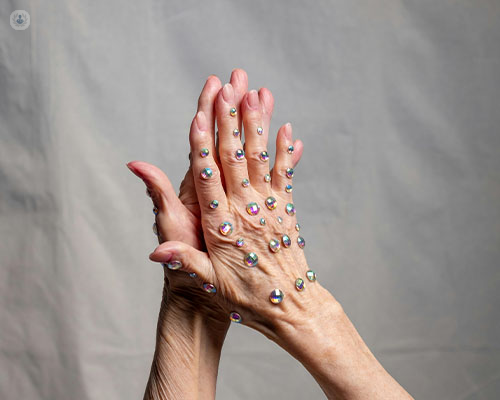Figuring out finger arthritis: what it is and how to treat it
Escrito por:Fingers express things that words cannot. We use fingers to gesture, play instruments, write, make new friends, and generally feel our way through the world. It can be upsetting when our fingers stop functioning in the ways we’re used to – and as we age, it could be finger arthritis that may have a hand in this. A top orthopaedic surgeon specialising in hand and wrists, Miss Sally-Anne Phillips helpfully points out the causes, symptoms, and treatment of finger arthritis.

What is finger arthritis?
Arthritis is an umbrella term for common diseases of the membranes and joints that are thought to affect primarily people over 40 years old; though rare, there are cases of young people with this condition as well.
Arthritis of the fingers can manifest due to a genetic disposition to the condition, family history, or previous traumatic injury resulting in a deterioration of the joints to the hands and fingers. Contrary to popular belief, cracking your knuckles will not cause arthritis.
Types and symptoms of finger arthritis
Finger arthritis can be split into two categories: inflammatory and non-inflammatory. Types of inflammatory arthritis could be rheumatoid arthritis or gout, where there is swelling around the joints and the decay of the ligaments and cartilage of the fingers, affecting multiple joints at a time. A non-inflammatory kind of arthritis could be osteoarthritis, the most common kind where the cartilage around the joints thins and wears down, which means the finger bones rub together unprotected.
The main symptoms of finger arthritis are as follows:
- stiffness of the fingers, and difficulty executing fine movements or gestures
- lumps or roundness at the joints, particularly the ends and middles
- constant aches or pain
Treatments for finger arthritis
There are several options for relief for those suffering from finger arthritis, ranging from nonsurgical care to surgical procedures.
For nonsurgical treatments, strong painkiller medication or creams can be used to help manage the pain. Another recommendation is steroid injections to target the inflammation directly – this can be an immediate relief for the swelling and redness and is most applicable for those who have rheumatoid arthritis. Compression gloves and thumb splints can also be worn to reduce swelling and alleviate discomfort. Unfortunately, these options cannot assist with mobility issues.
Strangely enough, cream or gel made from capsaicin – yes, chilli peppers – has proven to be very effective pain relief for osteoarthritis, with reported improvement in function and stiffness
For surgical relief from extreme pain, it is possible to replace the joint entirely so that the bones are no longer rubbing against each other and should restore function, or fuse the joint so that the bone grows over instead; however, flexibility of the fingers will still be reduced.
If you are experiencing the difficulties of finger arthritis, Miss Sally-Anne Phillips is a talented surgeon who knows all the ins and outs of the hands and wrists. She is available for consultation via her Top Doctors profile


